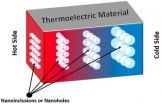(Press-News.org) Using diverse methodologies, neuroscientists from the RIKEN Brain Science Institute report that defects in Fatty Acid Binding Proteins (FABPs) may help to explain the pathology in some cases of schizophrenia and autism spectrum disorders. After identifying mutations in FABPs from patients, the group led by Senior Team Leader Takeo Yoshikawa determined that the genetic disruption of Fabps in mice mimics disease behaviors seen in patients. This work suggests that disruption of FABPs could be a common link underlying some forms of these two prevalent mental disorders.
Published in the journal Human Molecular Genetics, the study reported that fatty acid binding proteins (FABPs), a component of lipid metabolism, are genetically linked to schizophrenia and autism spectrum disorder (ASD) in humans and dysfunctional behaviors in mice. The findings provide support for the involvement of lipid metabolism in the spectrum of cognitive disorders.
The brain is composed of lipids that provide structure and signaling functions, and disruption of lipid transport to or within the brain can lead to anomalous neurological symptoms. Previous studies revealed abnormally low levels of some polyunsaturated fatty acids (PUFAs) including essential fatty acids in schizophrenic and autistic patients but failed to identify the responsible proteins. Consequently, Yoshikawa and his team decided to investigate FABPs ? molecules that facilitate the transport of PUFAs and other fatty acids. "Our prior study showed that disruption of Fabp7 in mice impaired neurogenesis, so we suspected that FABP7 and its family members had important roles in neurodevelopment", said Dr. Yoshikawa. The researchers focused on the major FABPs found in mature neurons and neuronal progenitors, FABP3, FABP5, and FABP7, to better understand their potential roles in mental disabilities.
The team found that the expression levels of FABPs in postmortem brain and blood cells of patients were altered. Using molecular analysis, the team identified specific mutations in FABP genes exclusively in patients, which caused an abnormal structure or function of these proteins, presumably preventing them from delivering the correct fatty acids to their target tissues and organelles inside cells.
To investigate the effect of Fabp loss in the brain, the researchers genetically inactivated the genes in mice and conducted behavioral tests. They found that mice lacking Fabps exhibited behaviors similar to those observed in human patients. Fabp3 knock-out mice showed a decrease in memory and social motivation, mirroring dysfunctional cognition and lack of interest in social communication in ASD patients. In contrast, Fabp7 knock-out mice displayed hyperactivity and anxiety, a phenotype similar to that observed in schizophrenic patients. "Although the amino acid sequence of the FABPs is similar, we think that they interact with different fatty acids and are expressed in different cells with distinct timing during development. This is likely the reason that the behaviors in the mice are different for each member of the Fabp family", said Dr. Yoshikawa.
Both schizophrenia and ASD are caused by many factors and conventional treatment does not work well on all patients. These findings suggest that FABPs may define one mechanism for these disorders selectively affecting lipid transport systems that may complement other etiological factors. "Identification of FABP mutations in humans may to help us take a personalized treatment approach," said Dr. Yoshikawa. "We hope our finding will lead to the development of tailor-made therapies, providing patients with molecules that complement deficiencies caused by their particular mutation."
INFORMATION:
Defects in fatty acid transport proteins linked to schizophrenia and autism
2014-07-15
ELSE PRESS RELEASES FROM THIS DATE:
Smarter ads for smartphones: When they do and don't work
2014-07-15
NEW YORK — Brands spent $8.4 billion on mobile advertising in 2013, and that number is expected to quadruple to $36 billion by 2017, according to eMarketer. But do mobile display ads — those tiny banner ads that pop up in your smartphone's web browser — actually work? Researchers at Columbia Business School have found that, despite their size, mobile ads can have a big effect on consumers who are in the market for certain types of products.
"Digital advertising in mobile channels is experiencing explosive growth," said Miklos Sarvary, co-director of the Media Program ...
NASA sees Typhoon Rammasun's eye staring at Visayas, Philippines
2014-07-15
Early on July 15, Typhoon Rammasun began making landfall in the eastern part of the central Philippines and NASA's Aqua and TRMM satellites spotted the 20 nautical-mile-wide (23 mile/37 km) eye of the storm close to landfall.
Typhoon Rammasun was making landfall in the Visayas region. Visayas is located in the central Philippines.
The Tropical Rainfall Measuring Mission or TRMM satellite passed over Rammasun on Tuesday, July 15, 2014 at 04:10 UTC (12:10 a.m. EDT) and measured rainfall occurring throughout the storm. TRMM found moderate rainfall (about 35 mm)/1.4 inches ...
Scientists gear up to fight deadly snake fungal disease
2014-07-15
CHAMPAIGN, Ill. — Researchers have developed a faster and more accurate way to test for infection with Ophidiomyces ophiodiicola, a fungus that is killing snakes in the Midwest and eastern United States. The test also allows scientists to monitor the progression of the infection in living snakes.
The researchers reported on the test at the 2014 Mycological Society of America Annual Meeting.
"We need people to know that they don't have to anesthetize an animal to collect a biopsy sample or, worse yet, euthanize snakes in order to test for the infection," said University ...
This week from AGU: Dust models, Arctic Ocean waves, floods and climate change
2014-07-15
From AGU's blogs: Global climate models fail to simulate key dust characteristics
Climate models that simulate the airborne African dust that influences Atlantic Ocean hurricanes are not up to the task of accurately representing the characteristics of that dust, according to a new study accepted for publication in Geophysical Research Letters.
From AGU's journals: Surface waves contribute to ice retreat in Beaufort Sea
Surface waves, created by blowing wind, play a role in energy and nutrient transport and also shape coasts through erosion. Because the Arctic Ocean ...
New UK study helps scientists understand melanoma development
2014-07-15
LEXINGTON, Ky. (July 15, 2014) — A new study by University of Kentucky researchers shows how a genetic defect in a specific hormonal pathway may make people more susceptible to developing melanoma, the deadliest type of skin cancer.
Fair-skinned people who tend to burn (rather than tan) from sun exposure have a much higher risk for melanoma than darker-skinned people. On the surface, it appears that the amount of melanin, the natural substance in the skin that determines pigment and acts as the skin's "natural sunscreen," would be the only determinant of melanoma risk. ...
Directly visualizing hydrogen bonds
2014-07-15
WASHINGTON D.C., July 15, 2014 – Using a newly developed, ultrafast femtosecond infrared light source, chemists at the University of Chicago have been able to directly visualize the coordinated vibrations between hydrogen-bonded molecules -- the first time this sort of chemical interaction, which is found in nature everywhere at the molecular level, has been directly visualized. They describe their experimental techniques and observations in The Journal of Chemical Physics, from AIP Publishing.
"These two-dimensional infrared spectroscopy techniques provide a new avenue ...
New feathered predatory fossil sheds light on dinosaur flight
2014-07-15
LOS ANGELES—A new raptorial dinosaur fossil with exceptionally long feathers has provided exciting insights into dinosaur flight. A paper published in Nature Communications on July 15, 2014 asserts that the fossil—discovered by an international team led by Natural History Museum of Los Angeles County (NHM) paleontologist Dr. Luis Chiappe—has a long feathered tail that Chiappe and co-authors believe was instrumental for decreasing descent speed and assuring safe landings.
The 125-million-year-old dinosaur, named Changyuraptor yangi, was found in the Liaoning Province ...
New materials for future green tech devices
2014-07-15
WASHINGTON D.C., July 15, 2014 -- From your hot car to your warm laptop, every machine and device in your life wastes a lot of energy through the loss of heat. But thermoelectric devices, which convert heat to electricity and vice versa, can harness that wasted heat, and possibly provide the green tech energy efficiency that's needed for a sustainable future.
Now, a new study shows how porous substances can act as thermoelectric materials—pointing the way for engineering the use of such materials in thermoelectric devices of the future.
About 70 percent of all the energy ...
Widespread support for rapid HIV testing in dental surgeries -- new study
2014-07-15
More than 80 per cent of oral health patients are willing to receive rapid HIV-testing in dental settings, which could help reduce the spread of the HIV according to a groundbreaking study revealed today at a Sydney University HIV Testing Symposium.
The first of its kind study of 521 Sydney-based dental patients assessed patients' willingness to undergo rapid HIV testing in dental settings, their preference for HIV testing-type type and their willingness to pay for the test.
Rapid HIV testing is a screening test that swiftly detects the presence of HIV antibodies in ...
Hear Jane read: Rutgers University-Newark researcher gives new meaning to semantics
2014-07-15
For years a key way of diagnosing dyslexia has been how well a person reads aloud. Similarly, the reading skills of adult readers also have been assessed by having them read words aloud. "The idea is that the more you read in English, the more you will encounter words that don't follow standard rules of pronunciation, so it's an index of reading exposure and, presumably, ability," explains researcher William W. Graves. But are you a better reader if you pronounce a word based on its meaning, or based on its spelling? Does it make a difference? And why? Those are the ...





